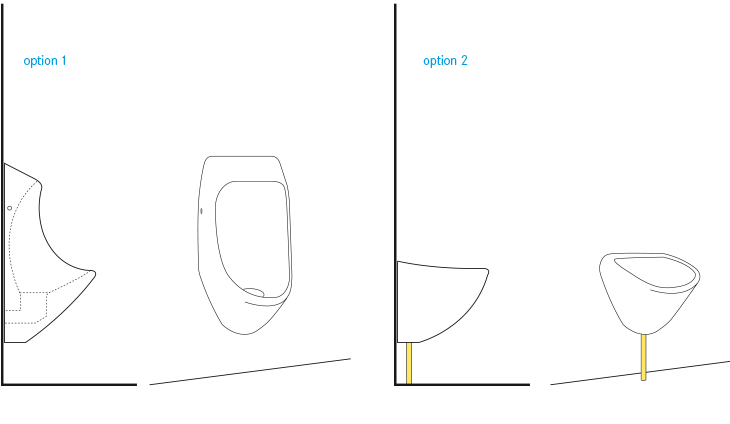
Executive Summary
An urinal is used only for collecting urine. Urinals are generally for men, although models for women have also been developed. Most urinals use water for flushing, but waterless urinals are becoming increasingly popular.
| In | Out |
|---|---|
| Urine, Freshwater |
Urine and Yellowwater |
Introduction
Urinals for women consist of raised foot-steps and a sloped channel or catchment area that conducts the urine to a collection technology. For men, urinals can be either vertical wall-mounted units, or squat slabs over which the user squats.
The urinal can be used with or without water and the plumbing can be developed accordingly. If water is used, it is mainly used for cleaning and limiting odours (with a water-seal).
Design considerations
For water-based urinals, the water use per flush ranges from less than 2 L in current designs to almost 20 L of flushwater in outdated models. Water-saving or waterless technologies should be favoured. To minimize odours and nitrogen loss in simple waterless urinal designs, the collection pipe should be submerged in the urine tank to provide a basic liquid seal.
Waterless urinals are available in a range of styles and complexities. Some urinals come equipped with an odour seal that may have a mechanical closure, a membrane, or a sealing liquid.
By putting a small target, or painted fly near the drain, the amount of spraying or splashing can be reduced; this type of user-guidance can help improve the cleanliness of the facility. Because the urinal is exclusively for urine it is important to also provide a toilet to be used for faeces.
Health aspects/acceptance
The urinal is a comfortable and easily accepted user interface. Although simple in construction and design, urinals can have a large impact on the well-being of a community. When men have access to a urinal, they may urinate less often in public, which reduces unwanted odours and makes women feel more comfortable. Men have generally accepted waterless urinals, as they do not call for any change of behaviour.
Operation & maintenance
Maintenance is simple, but should be done frequently, especially for waterless urinals. All of the surfaces should be cleaned regularly (bowl, slab and wall) to prevent odours and to minimize the formation of stains.
Particularly, in waterless urinals, calcium- and magnesium- based minerals and salts can precipitate and build up in pipes and on surfaces where urine is constantly present. Washing the bowl with a mild acid (e.g., vinegar) and/or hot water can prevent the build-up of mineral deposits and scaling. Stronger (> 24% acetic) acid or a caustic soda solution (2 parts water to 1 part soda) can be used for removing blockages. However, in some cases manual removal may be required.
For waterless urinals, it is critical to regularly check the functioning of the odour seal.
Urinals can be used in homes as well as within publicfacilities. In some cases, the provision of a urinal is useful to prevent the misuse of dry systems (e.g. UDDT).Portable waterless urinals have been developed for use at large festivals, concerts and other gatherings, to improve the sanitation facilities and reduce the point load of wastewater discharged at the site. In this way, a large volume of urine can be collected (and either used or discharged at a more appropriate location or time). The remaining toilets can be reduced in number or used more efficiently.
Urine-diversion. Ecological Sanitation Systems in South Africa
This publication includes directions for making a simple urinal using a 5 litre plastic container.
AUSTIN, A. DUNCKER, L. (2002): Urine-diversion. Ecological Sanitation Systems in South Africa. Ecological Sanitation Systems in South Africa. Pretoria: Council for Scientific and Industrial Research (CSIR)Waterless urinals: A proposal to save water and recover urine nutrients in Africa
Waterless urinals save water and they allow the collection of undiluted urine, which – because of its nitrogen and phosphorus content - is a valuable resource as fertiliser in agriculture. In the context of African developing countries, costs and maintenance requirements of waterless urinals need to be as low as possible. Despite the fact that hundreds of thousands of waterless (and odourless) urinals are now already in use worldwide, many municipalities are not yet aware of their existence or are reluctant to accept them as a viable option. This paper aims to reduce this knowledge gap by describing available models, odour control methods in waterless urinals (flat rubber tube, silicon curtain valve or sealant liquid), and the aspects to be considered regarding maintenance requirements and costs.
MUENCH, E. (2009): Waterless urinals: A proposal to save water and recover urine nutrients in Africa. In: Proceeding of the 34th WEDC International Conference, Addis Ababa, Ethiopia, 2009: URL [Accessed: 13.05.2019]Technology Review of Urine Diversion Components
The publication explains the purposes of urine diversion, its benefits and challenges, urine precipitation, urine treatment and reuse in agriculture. Further, it provides an overview on design and operational aspects for equipment needed, such as waterless urinals and urine diversion toilets including supplier information and indicative costs. Overall, it pulls together scattered knowledge around the topic of urine diversion in a concise manner.
MUENCH, E. von WINKER, M. (2011): Technology Review of Urine Diversion Components. Overview of Urine Diversion Components such as Waterless Urinals, Urine Diversion Toilets, Urine Storage and Reuse Systems. Eschborn: Deutsche Gesellschaft für Internationale Zusammenarbeit (GIZ) GmbH URL [Accessed: 11.05.2019]Smart Sanitation Solutions
Smart Sanitation Solutions presents examples of low-cost household and community-based sanitation solutions that have proven effective and affordable. A wide range of innovative technologies for toilets, collection, transportation, treatment and use of sanitation products that have already helped thousands of poor families to improve their lives is illustrated.
NWP (2006): Smart Sanitation Solutions. Examples of innovative, low-cost technologies for toilets, collection, transportation, treatment and use of sanitation products. (= Smart water solutions ). Amsterdam: Netherlands Water Partnership (NWP) URL [Accessed: 09.05.2019]

